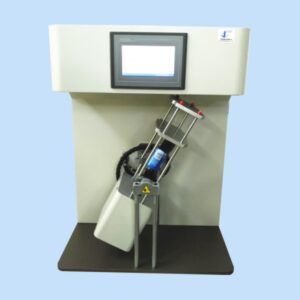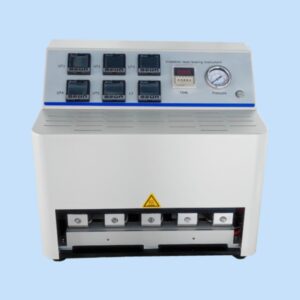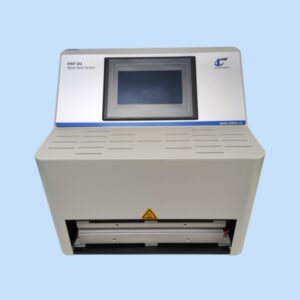LSG-01 Aluminum-Plastic Combination Cap Opening Force Tester
- Standard: ISO 8872, ISO 7500-1, ISO 10985, ISO 8362-6, ISO 8362-7
- Manufacturer: Cell Instruments
- Applications: Packaging materials, medical device materials, pharmaceutical testing, containers, and more.
- Customization: Available for special testing requirements and automation transformations
I. Introduction to the Aluminum-Plastic Combination Cap Opening Force Tester
The Aluminum-Plastic Combination Cap Opening Force Tester is a specialized instrument designed to measure the force required to open aluminum-plastic combination caps. These caps are widely used in industries such as pharmaceuticals, beverages, cosmetics, and food packaging to provide a secure yet accessible closure system. The instrument’s precision in testing is essential for ensuring product safety, consumer usability, and compliance with international standards.
Aluminum-plastic combination caps combine the durability of aluminum with the flexibility of plastic. These caps are often found in medical vials, beverage bottles, and cosmetics containers, where product integrity is of the utmost importance.
II. Test Methods for Aluminum-Plastic Combination Cap Opening Force
The opening force of aluminum-plastic combination caps is a critical factor in product safety and usability. The Aluminum-Plastic Combination Cap Opening Force Tester measures several key forces:
1. Tab Tear-Off Force
- Standards: ISO 8872, ISO 10985
- Description: This test evaluates the force required to tear off the tab, an essential feature of tamper-evident caps. The force must be sufficient to ensure tamper evidence but low enough for consumer accessibility.
2. Force Required to Pull Off Plastic Component
- Standard: ISO 10985
- Description: This test measures the force needed to remove the plastic part of the cap. This is crucial for ensuring that the seal remains intact during storage and transport, yet is easy to open when needed.
3. Force to Remove Plastic Component
- Standards: ISO 8536-7, ISO 8536-6
- Description: This test evaluates the force required to completely remove the plastic component from the cap. It ensures the packaging remains intact during storage but can be easily opened when necessary.
4. Tensile and Elongation Force for Aluminum Part
- Description: This test measures the tensile and elongation force on the aluminum component of the cap, ensuring the cap can withstand mechanical stresses.
III. Key Features of the Aluminum-Plastic Combination Cap Opening Force Tester
The Aluminum-Plastic Combination Cap Opening Force Tester is equipped with several advanced features that ensure accurate and reliable results in line with international testing standards such as ISO 8872, ISO 7500-1, ISO 10985, ISO 8362-6, and ISO 8362-7:
- Industrial-Grade PLC Control System: Ensures stability and precision during testing with easy-to-use Human-Machine Interface (HMI).
- Versatile Testing Capabilities: Supports multiple types of tests, including tensile, compression, peel, puncture, and breaking force, allowing for comprehensive analysis.
- Real-Time Display of Results: Test results are displayed instantly for quick data analysis, saving time during quality control procedures.
- Data Output Options: Includes microprinter output for easy record-keeping, as well as an optional RS232 interface for connecting to external data analysis systems.
- Safety Features: Equipped with overload protection, power-off memory, and automatic return to ensure operator safety and consistent test performance.
IV. Wide Applications in the Packaging Industry
The Aluminum-Plastic Combination Cap Opening Force Tester is essential for industries where product integrity and ease of use are critical, including:
- Pharmaceutical Packaging: Ensures vial caps are secure but user-friendly, maintaining sterility while allowing for easy removal.
- Beverage Bottles: Ensures that bottle caps provide a strong seal, while remaining easy to open by consumers.
- Cosmetics Containers: Validates the tamper-evidence and seal integrity of packaging, protecting delicate contents from contamination.
- Food Packaging: Ensures airtight seals on food containers, preventing spoilage while maintaining consumer convenience.
These applications highlight the importance of reliable and accurate force measurement in maintaining product quality, regulatory compliance, and consumer satisfaction.
V. Relevant International Standards
Ensuring compliance with international standards is a key factor in packaging quality assurance. The Aluminum-Plastic Combination Cap Opening Force Tester adheres to the following standards:
- ISO 8872: Focuses on medical packaging requirements, specifically the forces involved in tear-off features of caps and closures.
- ISO 7500-1: Ensures that testing machines for force measurement are properly calibrated and deliver accurate results.
- ISO 10985: Covers the testing of forces required to remove the plastic components of medical packaging.
- ISO 8362-6: Describes the performance and testing of injection vial caps, ensuring product safety in pharmaceutical packaging.
- ISO 8362-7: Specifies the requirements for aluminum-plastic combination caps used in the medical industry.
VI. Process and Significance of the Cap Opening Force Test
The testing process for aluminum-plastic combination caps involves several steps:
- Preparation: The cap is placed in the tester’s fixture, ensuring it is correctly aligned for accurate force application.
- Force Application: The appropriate test method is selected (e.g., tab tear-off force), and the machine applies force to the cap.
- Real-Time Monitoring: The tester measures the force in real-time and displays the results on the screen.
- Data Recording: Results are stored via the microprinter or exported through the RS232 interface for further analysis.
- Analysis: Data is analyzed against industry standards (ISO 8872, ISO 10985, etc.) to ensure the cap meets all relevant criteria.
Significance: Proper testing of aluminum-plastic combination caps ensures that they perform their intended function—protecting product integrity while providing user convenience. Adhering to standards such as ISO 8872 and ISO 10985 ensures that caps meet global quality and safety requirements.
VII. FAQs
1. What industries benefit from aluminum-plastic combination cap testing?
- Industries such as pharmaceuticals, beverages, cosmetics, and food packaging benefit from ensuring the safety, usability, and compliance of their packaging materials.
2. Why is it important to measure the opening force of aluminum-plastic combination caps?
- Measuring the opening force is crucial for maintaining product integrity while ensuring consumer ease of use. It prevents premature openings or difficulty in opening the product.
3. Which standards govern the testing of aluminum-plastic combination caps?
- Key standards include ISO 8872 (medical packaging), ISO 10985 (plastic component removal), and ISO 8536-7 (cap integrity), among others.
4. How does the Aluminum-Plastic Combination Cap Opening Force Tester ensure accurate results?
- The tester uses an industrial-grade PLC system, real-time monitoring, and high-precision sensors to deliver accurate and reliable results in compliance with international standards.
5. Can the Aluminum-Plastic Combination Cap Opening Force Tester be customized for different testing needs?
- Yes, the tester is compatible with various accessories and can be customized to meet specific industry and product testing requirements.





